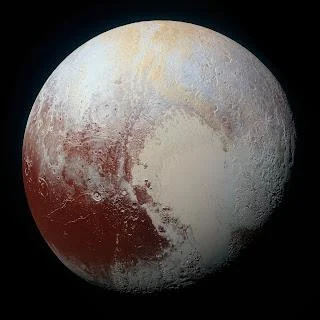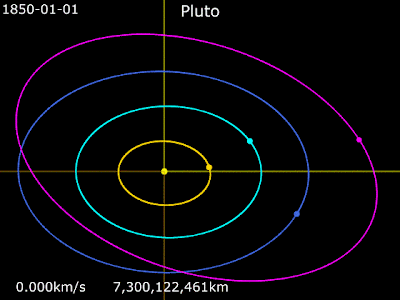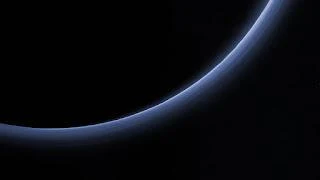At the outermost reaches of our solar system, away from all the warmth and light of the Sun, where during high noon the mercury slips below negative three hundred and eighty-seven degrees Fahrenheit (negative two hundred and thirty-two on the Celsius scale), there hangs a planet — or (perhaps) not.
Even after accounting for the orbital variations of Uranus due to the gravitational influence of Neptune, the former still maintained its irregularities. The deviations weren't large, and at the same time, they weren't small enough to be cast off as (unintended/inherent) observational (and from there, computational error). Once again, the odds rested on another possible planet beyond Neptune, the ninth orb from the Sun. The hunt for the ninth planet, popularized as Planet X, was given momentum by Percival Lowell, director of Lowell Observatory in Arizona, USA, who had already landed himself in the greatest controversy in the history of astronomy — intelligent (advanced) beings lived on Mars who constructed elegant canals to channel water from the ice-capped poles across the arid desert of a planet. For ten years, starting in 1906 till his untimely death (from a stroke) in 1916, Percival Lowell exhausted himself but couldn’t find Planet X.
When V.M Slipher succeeded Percival to the director's chair, he gave it a try, but to no avail. Frustrated, he threw the challenge upon Clyde Tombaugh, his newly recruited assistant. Using a blink comparator, Tombaugh shifted through hundreds of photographic exposures gathered on successive nights. After a year of toiling labor, on February 18, 1930, he knew he had got it --- in the miscellaneous scatter of distant stars, there was this tiny dot --- there was Planet X.
 |
Enhanced color photograph of Pluto's Northern Hemisphere. What strikes out most in this portrait is the Heart Shaped flatland known as Sputnik Planitia also known as Tombaugh Regio. Credit: NASA/Johns Hopkins University Applied Physics Laboratory/Southwest Research Institute |
Orbital dynamics: Pluto has the strangest dynamics in our solar system. At nearly 5.9 billion km (~ 3.7 billion miles, 39.48 au) away from the Sun, Pluto's orbital period stretches to a lengthy 248 Earth years. In the 76 years since its discovery, Pluto hasn't yet covered one-third of its trajectory. But that's not it. While all the planets track the Sun in an almost identical plane, Pluto's orbit tilts over 17 degrees to what is known as the ecliptic. But what really beats it is the fact that Pluto's orbit cuts across Neptune's and, for a brief phase, enjoys being the eighth farthest planet from the Sun. Despite the ''cutting in'', Neptune and Pluto face virtually no risk of running into each other head-on as they whirl under a stable 3:2 orbital resonance. A day on the frozen terra equals to approx. 6.4 Earth days. Pluto's 122°axial tilts roll the planet on its side as it spins retrograde from east to west, with the Sun rising due west and setting due east (opposite to what we have on Earth).
 |
Animation of Pluto's orbit from 1850 to 2097. The yellow dot where the cross hairs meet
represents the Sun; the first (ochre) orbit is of Saturn; cyan blue stands for Uranus;
navy blue means Neptune; lilac is Pluto.
Credit: From Wikimedia Commons (link to original) |
Internal Composition and Surface Features: Pluto's mean diameter measures 2376 km (1476 miles); for comparison, the Moon's mean diameter touches 3474 km (2158 miles). An overall density of 1.86 g/cc suggests Pluto likely has a differentiated interior - a silicate core enveloped by a liquid water ocean and topped with an icy surface. Pluto's surface is marked by innumerable impact craters, mountains, valleys, serrated ridges, and endless plains of water, ammonia, and nitrogen ice frozen in perpetuum. A true-color portrait of Pluto's northern hemisphere reveals a contrasting palette of some reddish brown to dark orange, which hints at the presence of carbon monoxide and methane. One notable feature includes the Tombaugh Regio or the Heart, indeed a heart-shaped plain. Removed from the warmth of the Sun, Pluto's surface temperature ranges between 33 - 55K(-240℃ to -218℃). Such rigid temperatures spell inhospitable to earth life, although, in the subsurface ocean, if there's water, if there's residual heat from radioactive decay, there lies exotic possibilities.
 |
Pluto's Atmosphere
Credit: NASA/Johns Hopkins University
Applied Physics Laboratory/Southwest Research Institute
|
Atmosphere: With 1/12 of Earth's gravity, Pluto drapes itself with a tenuous atmosphere which is (by volume) mostly nitrogen, with trace amounts of methane, carbon monoxide, ethane, ethylene, acetylene, hydrocarbons, tholins, and organic volatiles. One feature of Pluto's atmosphere is that its overall volume expands and shrinks as the planet moves closer to the Sun and then migrates away. Upon closer observation, Pluto's atmosphere blows a haze over the underworld. Since Pluto's magnetic field is absent, so is its magnetosphere — without which life as we know it on Earth looks at total annihilation.
Natural Satellites: Styx, Nyx, Kerberos, and Hydra, plus Charon, are the five natural satellites. Charon is an oddity, for not only it's the largest of the Plutonian moons, but it's almost comparable in size to its primary, Pluto. As a result, they have fallen into an extreme situation of tidal locking — the kind where they both turn the same face towards the other and behave as the other's moon instead of sharing the standard primary-satellite relationship. All five of Pluto's moons maintain a mean-motion orbital resonance, and their orbital radii range between 17,536 km from Charon to 64,738 km for Hydra. The moons probably formed from a violent collision with some other celestial body, and except Charon, all are irregular in shape.
Explorations: Pluto's sheer distance removes it from the bucket list of planetary objects humanity aims to set upon in this century. Even robotic missions are not an easy task. So far, there's been one mission — New Horizons, a flyby mission launched by NASA on January 19, 2006. The probe made its closest approach on July 14, 2015, picking up dust at 12,00 km (7,800 mi) above the frozen surface. Mission accomplished, New Horizons remains operational, and as of today (October 28, 2023), the spacecraft is at a distance of 57.62 au from the Sun, flying through the Kuiper Belt.
(Virtually) the same stuff that populates the space between Mars and Jupiter, hundreds of thousands of asteroids, minor planets, and planetoids — seeds that never grew into major planets, fill the realm beyond Neptune. Almost similar in physical characteristics to their cousin, the asteroid belt, these objects sell under the fancy name of Trans-Neptunian Objects or TNOs. TNOs are further classified into Classical or Resonant Kuiper Belt Objects (KBOs), Sednoids (after minor planet Sedna), Scattered Disc, Neptune Trojans (planetary debris stuck in Neptune's orbit), and Detached Objects. The Kuiper Belt extends further at 2,000 au from the Sun, beyond which it morphs into the Oort Cloud, believed to be a spherical shell of asteroids, comets, and planetary debris.
 |
Earth, Moon, and Pluto in comparison.
Credit: NASA |
Pluto is not much of a planet; it is a classic relic, among others, placed at the very edge of the solar system, beyond which lies the most treasured orbs. KBOs are of special interest to scientists trying to unravel not just the tangled birth of the solar system but the chemistry leading to the origin of life itself. Perpetually frozen, astronomers opine that these KBOs had been left in pristine condition, their compositions (virtually) unchanged over four billion years.
First Published: June 10, 2021
Updated on: November 06, 2023



Comments
Post a Comment